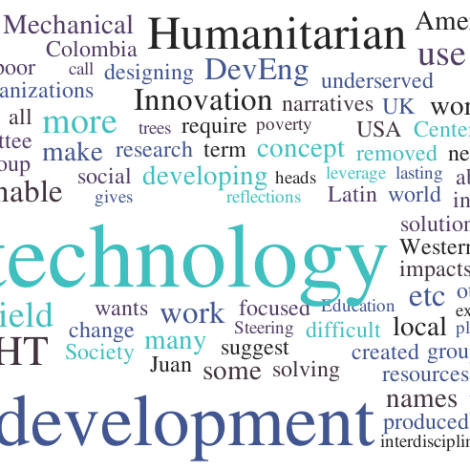Organizations around the world have adopted at least a dozen names, probably more, for the work that we do building and designing technology that meets basic needs in underserved communities. A word cloud would include terms such as “design for extreme affordability,” and one we favor at Engineering for Change, “essential technology.” We sent out queries to the heads of design firms, non-profit engineering groups, academic programs and others to ask them why they chose the words that they use to describe our field. Their answers suggest which aspects of the work they value and hint at their guiding visions. This is what we learned.
“Development engineering” (“DevEng”)
For us, Development Engineering (“DevEng”) has been a bit of a misnomer in that it implies a subset of engineering to a lot of audiences. I think it’s something much bigger than that.
What we intend DevEng to be is an interdisciplinary approach to development challenges, recognizing that many skillsets and talents need to be deployed to effect lasting change to improve lives. As such, I think of DevEng as “re-engineering” the field of development to include engineers, business people, economists, social scientists, designers, and others to come together to address poverty.
— Sophi Martin, Innovation Director at the Blum Center for Developing Economies, University of California, Berkeley (USA)
“Appropriate technology”
Originally the term “Appropriate Technology” was thought up by the Intermediate Technology Development Group when they started the magazine many years ago. In 2000, the magazine was sold to Research Information Ltd, the present publishers.
I like the definition of “appropriate technology” produced by the organization Appropriate Technology Asia:
“Appropriate Technologies are flexible, adaptable and are productive without harming the environment. They use locally available materials and can be produced in villages or small workshops, often using existing skills. They require only small amounts of capital, are small in scale, and affordable. They are relatively labour intensive and provide opportunities for local involvement and innovation. They do not require a high level of specialised training, and instead rely on community-led organisation and initiative.”
— David Dixon, Editor of Appropriate Technology Magazine based in Chetnole, Sherborne (UK)
“Humanitarian engineering” (“Ingeniería Humanitaria”)
We use concepts to refer our work with marginalized communities. One is “Humanitarian Engineering,” because we have some reflections about Human Rights and the importance for all the people. This concept was created by scholars in the US (Juan Lucena, Kevin Passino, Bernard Amadei, Carl Mitcham and David Munoz), and also in the UK. But, we know that this concept comes from the Global North, and for us it is necessary to problematize it.
In Latin America, we are working in some alternative narratives in the engineering field working with communities. We don’t have a concept yet, but we created a Latin American network call Engineering and Social Development to start the discussion of this issue.
— Juan David Reina Rozo, industrial engineer at the Center for Innovation in Appropriate Technologies and Education (C-Innova) at the Universidad Nacional de Colombia in Bogotá (Colombia)
“Engineering for global development” (“EGD”)
There are lots of “EGD-esque” names these days, like: “humanitarian engineering,” “design/engineering for the BoP,” “engineering for the developing world,” “design for extreme affordability,” etc. etc. When used by Western engineers, these names can sometimes suggest designing for poor people and/or Western engineers working to change the behaviors of the poor (i.e. get people to use clean-burning cookstoves instead of three-stone fires).
What I like about EGD is that it can be interpreted more broadly. “Global development” is the development of a sustainable planet for all, whether you’re a mother in a developing country that wants to buy a clean cookstove, or a gas-guzzling Coloradan who wants to develop renewable energy solutions. EGD gives ASME (American Society of Mechanical Engineers) the freedom to select which narratives are most important to global development at the time.
— Heather Fleming, CEO of Catapult Design in Denver, Colorado and member of the Engineering for Global Development Committee of the American Society of Mechanical Engineers (USA)
“Humanitarian technology”
IEEE (the Institute for Electrical and Electronics Engineers) is focused on electrical-engineering based technology. So, we are applying our technology to humanitarian problems. Traditionally, everyone in IEEE thinks their work is advancing technology for humanity. The problem is that advanced graduate-level research is rarely applicable to solving tactical problems (within a 1–5-year timeframe). Technology from the laboratory takes 15–20 years to transition to the marketplace. Many interesting technical ideas never make it out of the lab. SIGHT (IEEE Special Interest Group in Humanitarian Technology) is focused on the more direct application of technology to solving problems with more urgency.
[Dr. Lee also weighed in on why IEEE SIGHT does not use some of the other monikers for our field]
“Engineering for global development” – Implies economic impacts, affecting national and international policies, budget, and laws. So, this term is more removed from the IEEE technical community to grasp and make impacts. To be effective, EGD would need to closely collaborate between multiple disciplines; engineering and non-engineering (doctors, governments, policy makers, NGOs, educators, civil, mechanical, environmental engineers, etc.)
“Appropriate technology” – Very vague and means different things to each person. What is appropriate for me is not appropriate for you. If I decide for you, I am showing bias based on my perspective. Politically difficult.
“Frugal innovation” – Implies differentiation due to gaps—income, access to natural resources, etc. Is the opposite “wasteful”? Or “luxury”? Or “Sustainable”? Politically difficult.
“Sustainable technology” – Implies we are going to run out of resources in the future. Implies impact on environment, global warming, destruction of trees, uncontrolled accumulation of waste, pollution. It is one or two steps removed from IEEE’s field of interest.
IEEE SIGHT is a global network of IEEE volunteers partnering with underserved communities & local organizations to leverage humanitarian technology for sustainable development. IEEE SIGHT provides the framework to match our technical communities to local SIGHT groups to innovate appropriate solutions that will make a difference across the globe.
—Timothy Lee, Chair of IEEE SIGHT Steering Committee


testing the capitals here what’s up with this?